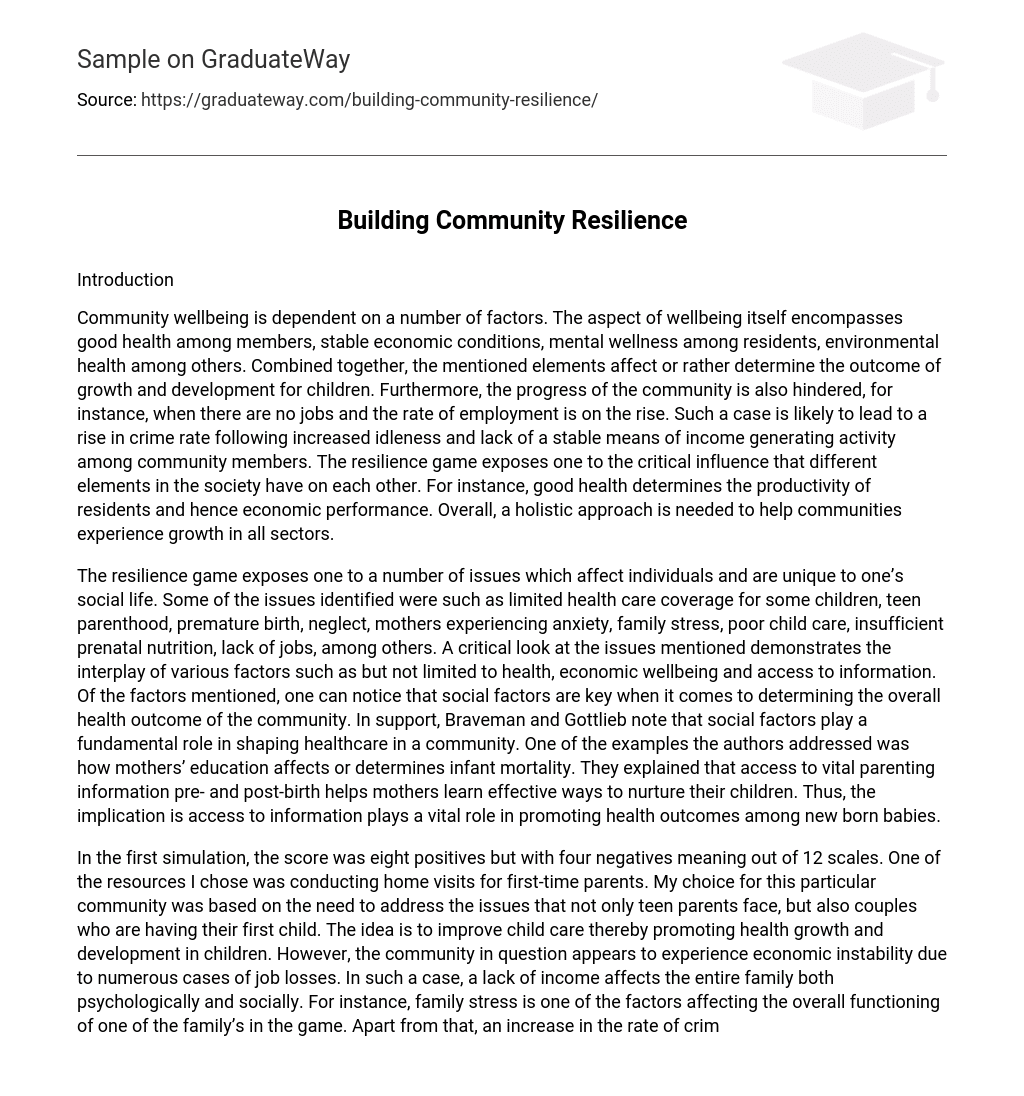Introduction
Community wellbeing is dependent on a number of factors. The aspect of wellbeing itself encompasses good health among members, stable economic conditions, mental wellness among residents, environmental health among others. Combined together, the mentioned elements affect or rather determine the outcome of growth and development for children. Furthermore, the progress of the community is also hindered, for instance, when there are no jobs and the rate of employment is on the rise. Such a case is likely to lead to a rise in crime rate following increased idleness and lack of a stable means of income generating activity among community members. The resilience game exposes one to the critical influence that different elements in the society have on each other. For instance, good health determines the productivity of residents and hence economic performance. Overall, a holistic approach is needed to help communities experience growth in all sectors.
The resilience game exposes one to a number of issues which affect individuals and are unique to one’s social life. Some of the issues identified were such as limited health care coverage for some children, teen parenthood, premature birth, neglect, mothers experiencing anxiety, family stress, poor child care, insufficient prenatal nutrition, lack of jobs, among others. A critical look at the issues mentioned demonstrates the interplay of various factors such as but not limited to health, economic wellbeing and access to information. Of the factors mentioned, one can notice that social factors are key when it comes to determining the overall health outcome of the community. In support, Braveman and Gottlieb note that social factors play a fundamental role in shaping healthcare in a community. One of the examples the authors addressed was how mothers’ education affects or determines infant mortality. They explained that access to vital parenting information pre- and post-birth helps mothers learn effective ways to nurture their children. Thus, the implication is access to information plays a vital role in promoting health outcomes among new born babies.
In the first simulation, the score was eight positives but with four negatives meaning out of 12 scales. One of the resources I chose was conducting home visits for first-time parents. My choice for this particular community was based on the need to address the issues that not only teen parents face, but also couples who are having their first child. The idea is to improve child care thereby promoting health growth and development in children. However, the community in question appears to experience economic instability due to numerous cases of job losses. In such a case, a lack of income affects the entire family both psychologically and socially. For instance, family stress is one of the factors affecting the overall functioning of one of the family’s in the game. Apart from that, an increase in the rate of crime within the neighborhood could also be a reason why for an urgent need for access to public resources. In their book, Jeffrey Jensen Arnett and Lene Arnett Jensen focus on some of the issues affecting the overall wellbeing of members in the community. Talking about the United States, the authors speak about how, for instance, there are limited cases of sex-based oppression as women are now able to access high-profile jobs in the corporate world. Such kind of focus demonstrates a paradigm shift in the society whereby women are given equal opportunities like men.
Even with their observation, Arnett and Jensen fail to explore the continued cases of gender-based violence across the U.S. In the resilience game, one of the factors noted was sex-based violence. The assumption is that an increase in the loss of jobs leads to, in part, exposure to domestic violence following increased economic pressure on families. Supporting the assertion above, Ilze Slabbert focuses on the link between domestic violence and poverty noting that women in low-income families are more vulnerable to domestic violence. She explains that poverty tends to limit choices and access to public resources. Thus, based on the information given, it becomes clear that improving the community’s wellbeing involves revamping its economic sector. One of the choices I made was to help educate residents on ways to keep a job. Doing so is likely to help community members adopt techniques at the workplace which could prevent them from being laid off. Hence, with a stable income, families will have access to basic social amenities such as health and education.
Conclusion
As mentioned earlier, some of the issues experienced in the community are related to lack of access to public resources. For instance, inability to access healthcare coverage means poor health outcomes. For a child especially one who was born prematurely or has birth defects or a genetic illness, it becomes difficult to acquire a healthy developmental pattern. However, Braveman and Gottlient explain that access to information and education could help eradicate or mitigate the effect of some of the issues identified. For instance, through promoting professional development in teachers, sex education can be taught effectively in schools. The result will be a reduction in the rate of teen parents. Therefore, with a minimal rate of individuals who are dependent on others for their wellbeing, the community will be able to focus on stabilizing itself in various sectors. Youth are likely to graduate from school and enter the employment sector. Therefore, establishing an information hub across the community could help prevent or mitigate the effects of some of the issues identified. With access to available labor, the community will be able to manage poverty levels thereby achieving economic self-sufficiency.
Works Cited
- Arnett, J. Jeffrey and Lene A. Jensen. Human Development: A Cultural Approach. Pearson.
- Braveman, Paula and Laura Gottlieb. “The social determinants of health: it’s time to consider the causes of the causes” Public health reports (Washington, D.C. : 1974) vol. 129 Suppl 2,Suppl 2 (2014): 19-31.
- Slabbert, Ilze. “Domestic Violence and Poverty.” Research on Social Work Practice, vol. 27, no. 2, 2016, pp. 223–230., doi:10.1177/1049731516662321.





